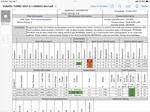UOA of the (roughly) 50-50% mix of Castrol 0w30 and 0w40. I will ask them to do a GC fuel dilution test, like I specifically asked for originally. Oil Analysers comments are crap, but I like that they do nitration, oxidation, and usually do GC fuel. But I don’t think they did the GC fuel this time, possibly because visc was “up to snuff” (sounds like Blackstone in a way), but they show the oil as 0w30, ignoring my comments it was a mix so “virgin visc“ was higher. It did lose a little visc: down to 11.9  .
.
Spoiler alert, single digit wear metals again (dang!!!), no surprises. No failure or real anomaly vs straight 0w-30. I will have to explain the Sodium anomaly from the previous UOA which I did not upload at the time. (I think I know why that happened). Prior to previous interval, I replaced an oil filter/oil cooler sleeve o-ring, and did a “test“ fill to check for leaks, the test fill was a very old Valvoline conventional; drained and refilled with Castrol Euro again after the test (I don’t remember if that was straight 0w30 or a mix 30 with 40). After getting the shocking UOA result, I researched and found some evidence old Valvoline of SM (?) vintage was very high in Sodium. I’m hoping that was the cause. Wish pb were zero, but hasn’t been for quite some time. 2ppm ain’t a catastrophe though.
but why in the Hades can’t OA get it through their heads that Castrol Edge includes Titanium, and it’s not a wear metal. And they mislabeled sample as (straight) 0w30, there was maybe 1/2 qt make-up, not 1 qt, and the sump is 4.25-4.5, not 4. hmmm, what else is wrong?
dang I wish my Ford Ecoboost had similar results. At 1/2 the mileage, the Ecoboost UOA results absolutely suck compared to the Subaru’s.
Spoiler alert, single digit wear metals again (dang!!!), no surprises. No failure or real anomaly vs straight 0w-30. I will have to explain the Sodium anomaly from the previous UOA which I did not upload at the time. (I think I know why that happened). Prior to previous interval, I replaced an oil filter/oil cooler sleeve o-ring, and did a “test“ fill to check for leaks, the test fill was a very old Valvoline conventional; drained and refilled with Castrol Euro again after the test (I don’t remember if that was straight 0w30 or a mix 30 with 40). After getting the shocking UOA result, I researched and found some evidence old Valvoline of SM (?) vintage was very high in Sodium. I’m hoping that was the cause. Wish pb were zero, but hasn’t been for quite some time. 2ppm ain’t a catastrophe though.
but why in the Hades can’t OA get it through their heads that Castrol Edge includes Titanium, and it’s not a wear metal. And they mislabeled sample as (straight) 0w30, there was maybe 1/2 qt make-up, not 1 qt, and the sump is 4.25-4.5, not 4. hmmm, what else is wrong?
dang I wish my Ford Ecoboost had similar results. At 1/2 the mileage, the Ecoboost UOA results absolutely suck compared to the Subaru’s.
Attachments
Last edited:

